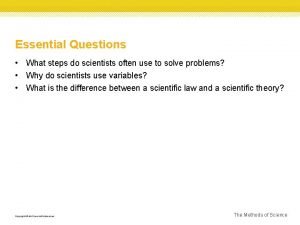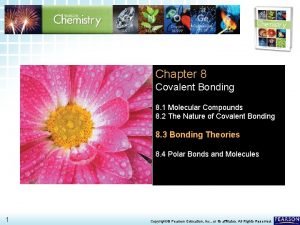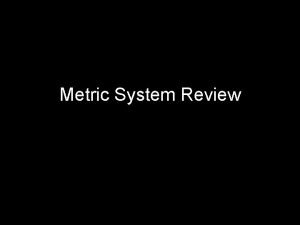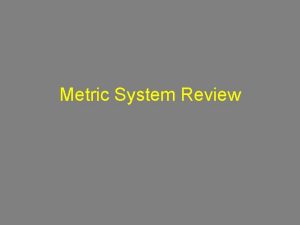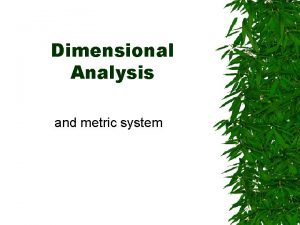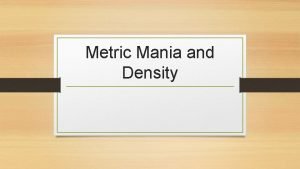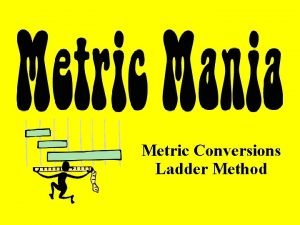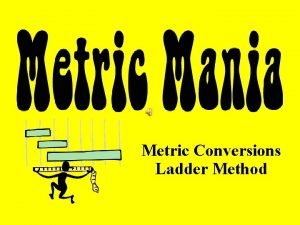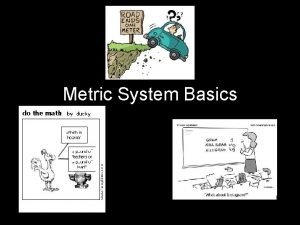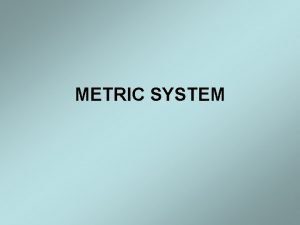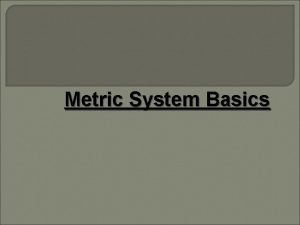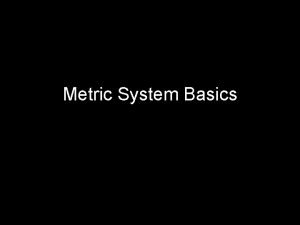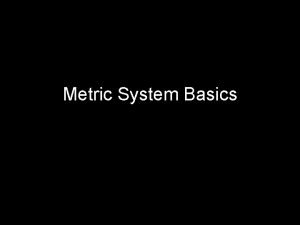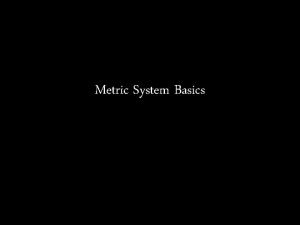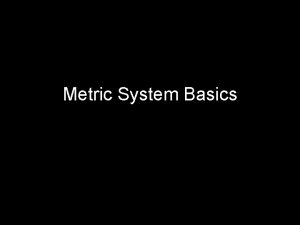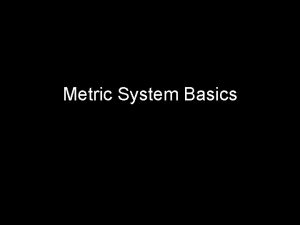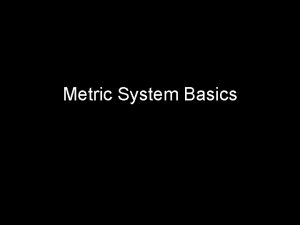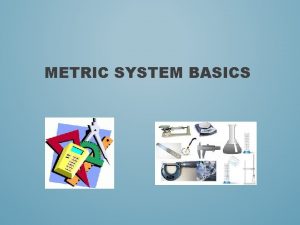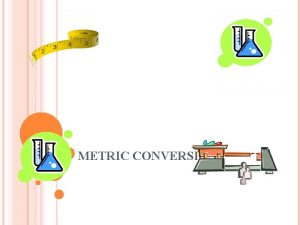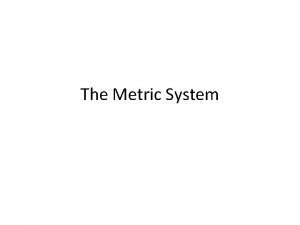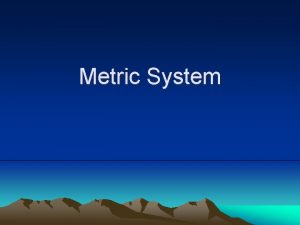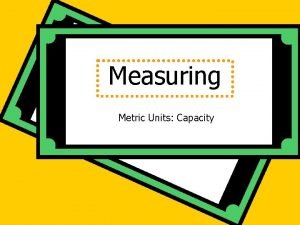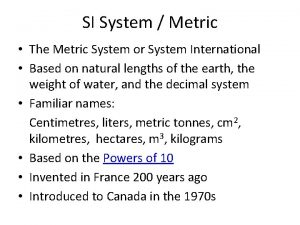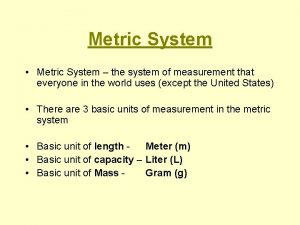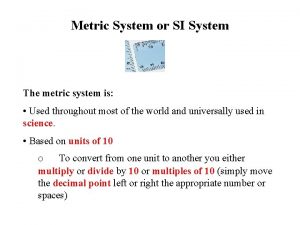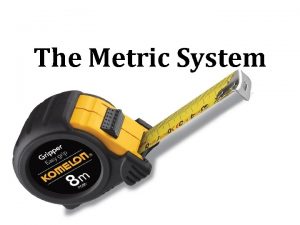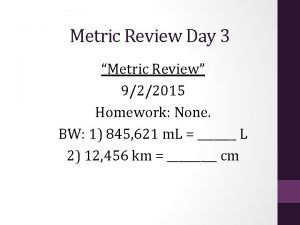Metric System Review Scientists use the metric system









































- Slides: 41

Metric System Review Scientists use the metric system to measure things such as volume, distance, and time. Meters, grams, seconds, degrees celsius,

Quantity Unit Symbol Length meter m Mass kilogram Kg Temperature Kelvin Celsius second K C s Time

Limits of Measurement You can only be as precise as the tools you use! Precision is a gauge of how exact a measurement is. Precision is the degree to which several measurements provide answers very close to each other ◦ Ex. 5 mins is less precise that 5 min 45 sec Accuracy is the closeness of a measurement to the actual value of what is being measured. ◦ Ex. If a clock is running 15 mins slow, then the clock is not accurate


What tools measure what quantities Mass ◦ Electronic balance, triple beam balance Volume ◦ Beaker, graduated cylinder, ruler Weight ◦ Spring scale Temperature ◦ Thermometer, temperature probe

THE METER The meter is the starting point for the metric system. START

Here’s a meter stick!

It takes 10 decimeters to make up 1 meter.

It takes 10 centimeters to make up 1 decimeter.

If 1 meter = 10 decimeters and 1 decimeter = 10 centimeters then how many centimeters make up 1 meter?

That’s right! 1 meter = 100 centimeters

100 centimeters = 1 meter

It takes 10 millimeters to make up 1 centimeter. Boy, that’s small!

If 1 meter = 10 decimeters and decimeter = 10 centimeters and 1 centimeter = 10 millimeters then how many millimeters make up 1 meter?

That’s right! 1000 millimeters = 1 meter

It takes 10 millimeters to make up 1 centimeter. Millimeters are so small that they almost run together.

Metric System These prefixes are based on powers of 10. What does this mean? ◦ From each prefix every “step” is either: 10 times larger or 10 times smaller ◦ For example Centimeters are 10 times larger than millimeters 1 centimeter = 10 millimeters Base Units kilo hecto deca meter gram liter deci centi milli

Metric System – Centimeters are 10 times larger than millimeters so it takes more millimeters for the same length 1 centimeter = 10 millimeters Example not to scale 40 1 mm 41 1 mm 1 mm 40 1 mm 41 1 cm

Metric System • For each “step” to right, you are multiplying by 10 • For example, let’s go from a base unit to centi 1 liter = 10 deciliters = 100 centiliters ( 1 x 10 = 10) = (10 x 10 = 100) 2 grams = 20 decigrams = 200 centigrams (2 x 10 = 20) kilo hecto deca meter liter gram = (20 x 10 = 200) deci centi milli

Metric System • An easy way to move within the metric system is by moving the decimal point one place for each “step” desired Example: change meters to centimeters 1 meter = 10 decimeters = 100 centimeters or 1. 00 meter = 10. 0 decimeters = 100. centimeters kilo hecto deca meter liter gram deci centi milli

Metric System • Now let’s try our previous example from meters to kilometers: 16093 meters = 1609. 3 decameters = 160. 93 hectometers = 16. 093 kilometers • So for every “step” from the base unit to kilo, we moved the decimal 1 place to the left (the same direction as in the diagram below) kilo hecto deca meter liter gram deci centi milli

Metric System • If you move to the left in the diagram, move the decimal to the left • If you move to the right in the diagram, move the decimal to the right kilo hecto deca meter liter gram deci centi milli

Metric System • Now let’s start from centimeters and convert to kilometers 400000 centimeters = 4. 00000 kilometers kilo hecto deca meter liter gram deci centi milli

Metric System • Now let’s start from meters and convert to kilometers 4000 meters = 4 kilometers kilo hecto deca meter liter gram deci centi milli • Now let’s start from centimeters and convert to meters 4000 centimeters = 40 meters kilo hecto deca meter liter gram deci centi milli

Metric System • Now let’s start from meters and convert to centimeters 5 meters = 500 centimeters kilo hecto deca meter liter gram deci centi milli • Now let’s start from kilometers and convert to meters. 3 kilometers = 300 meters kilo hecto deca meter liter gram deci centi milli

Metric System • Now let’s start from kilometers and convert to millimeters 4 kilometers = 4000000 millimeters or 4 kilometers = 40 hectometers = 400 decameters = 40000 decimeters = 400000 centimeters = 4000000 millimeters kilo hecto deca meter liter gram deci centi milli

Metric System • Summary – Base units in the metric system are meter, liter, gram – Metric system is based on powers of 10 – For conversions within the metric system, each “step” is 1 decimal place to the right or left – Using the diagram below, converting to the right, moves the decimal to the right and vice versa kilo hecto deca meter liter gram deci centi milli

This is a magnified image of a ruler/meter stick. 1 2 3 4 This is one centimeter.

This is a magnified image of a ruler/meter stick. 1 2 3 4 This is half of a centimeter.

This is a magnified image of a ruler/meter stick. 1 2 3 4 This is one millimeter.

This key measures 3 cm. 1 2 3 4

Or you could say that it measures 30 mm. 1 2 3 4

This key measures 2. 5 cm. 1 2 3 4

Or, you could say that it measures 25 mm. 1 2 3 4

1 2 This toy car measures 4. 2 cm. 3 4

1 2 3 4 Or, you could say it measures 42 m

Why is Scientific Notation Important? ? ? Scientific notation makes it easier to work with very large numbers or very small numbers. ◦ For example: 0. 00086 is written as 8. 6 X 10 -4 300, 000 is written as 3. 0 X 108

Now try these…. Write 3, 564, 000 in scientific notation. Write 0. 0043 in scientific notation. Remember only one number in front of the decimal point!!!

Were you right? 3. 564 4. 3 X 106 X 10 -3

2340000 . 058000 . 000781 . 0000000001 54010000 650000001

54 mm - ___m 13 k. L ____c. L . 54 Dg _____mg
 When is zero significant
When is zero significant What steps do scientists often use to solve problems?
What steps do scientists often use to solve problems? Why do scientists classify organisms
Why do scientists classify organisms What do scientists use vsepr theory for
What do scientists use vsepr theory for Metric system review
Metric system review Metric system
Metric system English metric system
English metric system Which country does not use the metric system
Which country does not use the metric system Metric mania notes
Metric mania notes Conversion ladder
Conversion ladder Metric ladder
Metric ladder Metric ladder method
Metric ladder method Hình ảnh bộ gõ cơ thể búng tay
Hình ảnh bộ gõ cơ thể búng tay Frameset trong html5
Frameset trong html5 Bổ thể
Bổ thể Tỉ lệ cơ thể trẻ em
Tỉ lệ cơ thể trẻ em Chó sói
Chó sói Glasgow thang điểm
Glasgow thang điểm Chúa yêu trần thế
Chúa yêu trần thế Môn thể thao bắt đầu bằng từ chạy
Môn thể thao bắt đầu bằng từ chạy Thế nào là hệ số cao nhất
Thế nào là hệ số cao nhất Các châu lục và đại dương trên thế giới
Các châu lục và đại dương trên thế giới Công thức tính độ biến thiên đông lượng
Công thức tính độ biến thiên đông lượng Trời xanh đây là của chúng ta thể thơ
Trời xanh đây là của chúng ta thể thơ Mật thư anh em như thể tay chân
Mật thư anh em như thể tay chân 101012 bằng
101012 bằng độ dài liên kết
độ dài liên kết Các châu lục và đại dương trên thế giới
Các châu lục và đại dương trên thế giới Thơ thất ngôn tứ tuyệt đường luật
Thơ thất ngôn tứ tuyệt đường luật Quá trình desamine hóa có thể tạo ra
Quá trình desamine hóa có thể tạo ra Một số thể thơ truyền thống
Một số thể thơ truyền thống Cái miệng bé xinh thế chỉ nói điều hay thôi
Cái miệng bé xinh thế chỉ nói điều hay thôi Vẽ hình chiếu vuông góc của vật thể sau
Vẽ hình chiếu vuông góc của vật thể sau Thế nào là sự mỏi cơ
Thế nào là sự mỏi cơ đặc điểm cơ thể của người tối cổ
đặc điểm cơ thể của người tối cổ V. c c
V. c c Vẽ hình chiếu đứng bằng cạnh của vật thể
Vẽ hình chiếu đứng bằng cạnh của vật thể Vẽ hình chiếu vuông góc của vật thể sau
Vẽ hình chiếu vuông góc của vật thể sau Thẻ vin
Thẻ vin đại từ thay thế
đại từ thay thế điện thế nghỉ
điện thế nghỉ Tư thế ngồi viết
Tư thế ngồi viết

